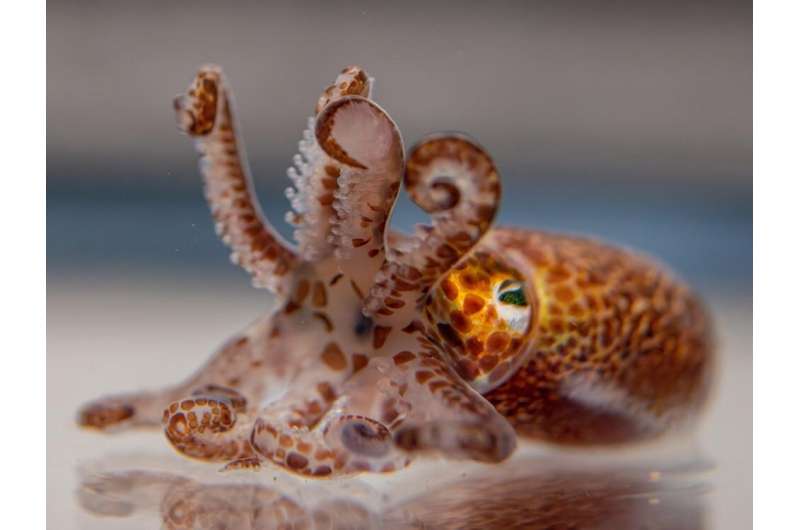This article has been reviewed according to Science X's editorial process and policies. Editors have highlighted the following attributes while ensuring the content's credibility:
fact-checked
peer-reviewed publication
trusted source
proofread
Bioluminescent bacteria coordinate signaling to colonize squid's light organ

Bioluminescent bacteria and the Hawaiian bobtail squid have formed a longstanding mutually beneficial relationship. How the bacteria coordinate their behavior to colonize the squid—through cellular signaling and cues from the environment—is detailed in a new study led by Penn State researchers.
A paper describing the study is published in the journal eLife. The researchers also show that the mechanism that they describe is likely to be widespread in a broad array of bacteria and that understanding this coordination of cellular signaling will be important for understanding how bacteria colonize their hosts more generally.
"The bacteria we study, known as Vibrio fischeri, is associated with many different marine hosts, but its association with the Hawaiian bobtail squid is the best characterized," said Tim Miyashiro, associate professor of biochemistry and molecular biology in the Penn State Eberly College of Science and the leader of the research team.
The squid have a specialized light organ tucked within the underside of their mantle that is occupied by the bacteria. The bacteria's glow is believed to help camouflage the squid when viewed by potential predators from below. The bacteria, in turn, get nutrients from the squid to support their growth. The squid, however, are not born with the bacteria in their light organs. Bacteria from the environment must make their way into the light organ after the squid hatch.
"Aspects of bacterial behavior in the light organ have been characterized," said Miyashiro, "but the cellular mechanisms that allow the bacteria to colonize the squid in the first place are still poorly understood, so we set out to investigate how the bacteria initiates colonization."
Inside the light organ, bacterial behavior is coordinated through "quorum sensing." The bacteria release signaling molecules that increase in concentration as the bacterial population grows and becomes denser. When enough bacteria are present—when a quorum is reached—a signaling pathway is activated such that the bacteria will begin to produce bioluminescence and their ability to move is suppressed. Prior to colonizing the light organ, the bacteria form large aggregates of cells as well, but if the quorum sensing pathway were activated they might not be motile enough to move into the light organ.
"So, the question is 'how do the bacteria avoid the quorum sensing pathway when they form these large aggregates outside of the squid and instead initiate behavior that promotes colonization?'" said Miyashiro. "What we saw was that the aggregation pathway activates the production of a small RNA molecule that is normally repressed by quorum sensing. Therefore, when the signaling pathway that leads to aggregation is activated outside the squid, the RNA molecule is expressed, which enables the cells to bypass quorum sensing to remain motile and dark."
The small RNA—called Qrr1—is part of the quorum sensing pathway that represses the ability of the bacteria to produce bioluminescence and promotes motility until a quorum is reached. When a quorum is reached, expression of Qrr1 is subsequently shut down.
"Qrr1 has also been shown to be important for promoting colonization," said Miyashiro. "You might expect that Qrr1 would be repressed during aggregation like it is during quorum sensing, but that is not what happens. So, we performed a number of experiments aimed at characterizing the molecular control of Qrr1 expression during aggregation."
The researchers showed that Qrr1 can be activated by a transcription factor—a protein that controls when and where genes are turned on in a cell—that also controls genes involved in aggregation. The transcription factor—a protein called SypG—is similar to the one used to regulate Qrr1 by the quorum sensing pathway This similarity enables SypG to promote expression of Qrr1 in the aggregates during colonization and ensures Qrr1 is not expressed once inside the light organ to allow bioluminescence.
"This complex regulatory architecture that controls Qrr1 expression allows it to play these two important roles and helps coordinate the shift in behavior from colonization to bioluminescence," said Miyashiro. "When we look across the bacterial family that includes V. fischeri, we see very similar structures that suggest to us that this type of coordination is likely to be important for many symbiotic bacteria."
More information: Ericka D Surrett et al, Two enhancer binding proteins activate σ54-dependent transcription of a quorum regulatory RNA in a bacterial symbiont, eLife (2023). DOI: 10.7554/eLife.78544
Journal information: eLife
Provided by Pennsylvania State University




















